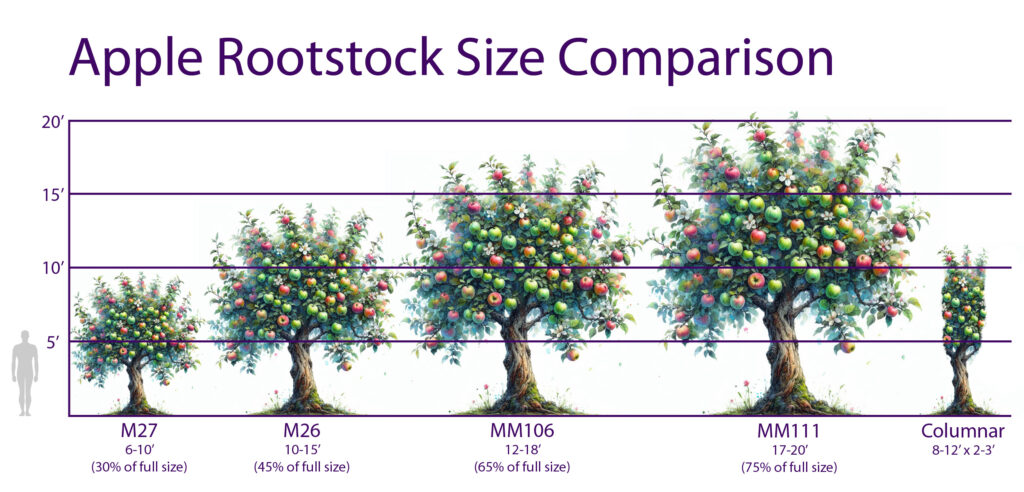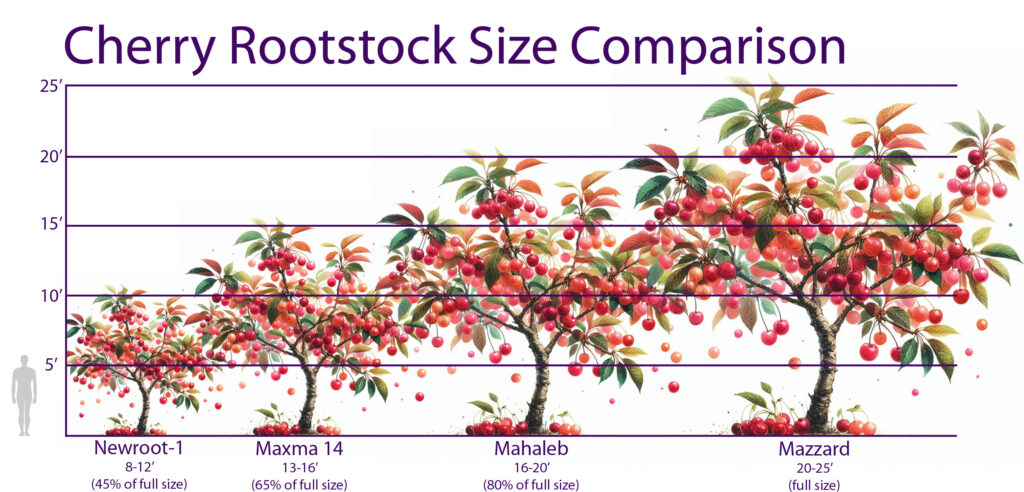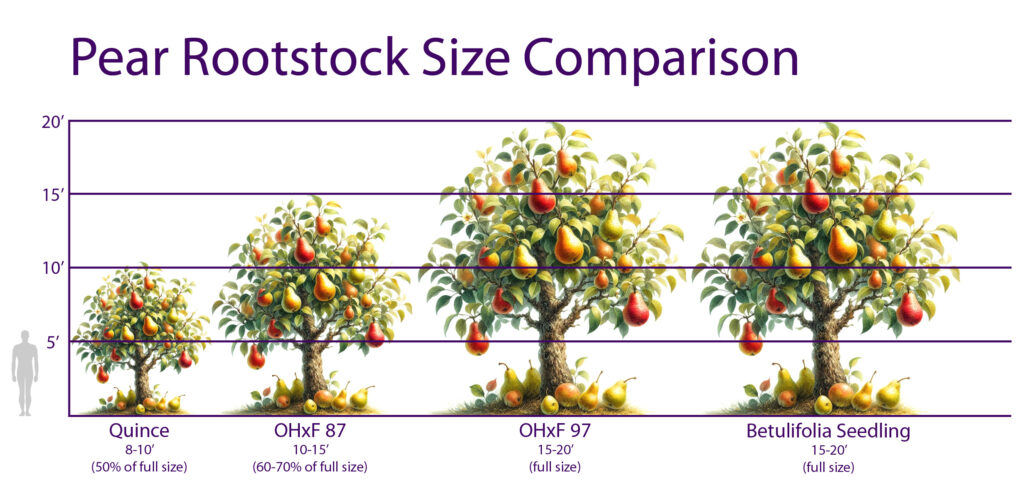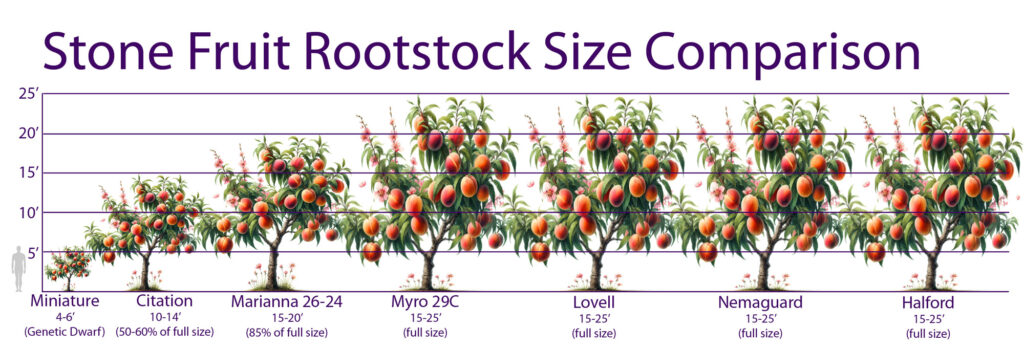Fruit Tree RootsTock
Fruit trees are comprised of two parts, the scion and the rootstock. The scion is the portion of the tree that is above ground while the rootstock is the portion below ground. They are joined just above the soil level by grafting.
The scion is the desired fruit variety, like Honeycrisp Apple, or Redhaven Peach. Even though that is the portion that we are typically most interested in, the rootstock is also very important. The rootstock influences the size of the tree and gives the tree other desirable characteristics.
While there are many different rootstocks that are used for fruit trees, these are the rootstocks that we most commonly select for our trees.
Read more about our bare root fruit trees.
Apples
Trees can be held to any height with summer pruning.
M27 – An extremely dwarfing rootstock for apples keeping most trees at 6-8 ft with some more vigorous varieties like Granny Smith and Gravenstein growing 8-10 ft tall. M27 induces heavy fruiting on young trees. Small root system that requires constant soil moisture and staking when young.
M26 – Keeps tree at 45-55% of standard height. It is a vigorous, dwarfing rootstock. Very productive and promotes fruit on young trees. Small root system on these trees may require staking when young.
MM106 – A great semi-dwarf root stock that keeps apple trees to 60-70% the size of a standard seedling. Resistant to woolly apple aphid. Grows well in many soil types, but does not tolerate very wet soils well.
MM111 – Good all-around choice for apples. This rootstock keeps the tree at just 80-90% of standard, or 17-20 ft. However, trees can be held to any desired height with summer pruning. MM111 induces fruiting on young trees. Tolerates wet, dry or poor soil. Provides resistance to woolly apple aphids and collar rot.

Cherries
Trees can be held to any height with summer pruning.
Newroot-1 – Also known as Z-Dwarf rootstock for cherries. Keeps cherry trees at 8-12 ft if unpruned. Promotes bearing fruit early. Ideal for growing in containers. Better adapted to clay soils than Mazzard or Mahaleb.
Maxma 14 – Dwarfing rootstock for sweet cherries keeping trees to 65% of standard size. Induces early, heavy bearing. Good tolerance to wet soils and also does well in calcareous soils. Resistant to bacterial canker and nematodes. Well anchored tree with very little suckering.
Mahaleb – The most winter hardy of the commonly used cherry rootstocks. Semi-standard sizing, dwarfs trees to about 80% of standard size, 14-16′ H x 16-20′ W. No dwarfing on sour cherry types. Induces fruiting on young trees with heavy crops. Resists crown gall, bacterial canker and some nematodes. Not tolerant of wet soils.
Mazzard – Standard size rootstock for sweet cherries, 18-20′ H x 20-25′ W. Vigorous and more tolerant of wet soils than Mahaleb (but still requires good drainage). Resistant to root-knot nematodes and oak-root fungus.

Pears
Trees can be held to any height with summer pruning.
Quince – One of the most widely used dwarfing pear rootstocks. Keeps tree size at 50% of standard, 8-10′ H x 6-8′ W. Some pest & disease resistance.
OHxF 87 – A semi-dwarf rootstock keeps tree size at 60-70% of standard size, 10-15′ H x 9-12′ W. Produces fruit very well, setting early and bearing heavily.
OHxF97 – Vigorous trees that are widely adapted and disease resistant. Standard tree size, 15-20′ H x 12-15′ W. Tolerant of wet soils with few root suckers.
P. betulifolia seedling – Standard size rootstock pears, 15-20′ H x 12-15′ W. Tolerant of wet or dry soils.

Stone Fruit – Almond, Apricot, Nectarine, Peach, Plum
Sizing on Apricot, Peach and Plum trees is primarily controlled through pruning rather than rootstocks.
Trees can be held to any height with summer pruning.
Miniature / Genetic Dwarfs – These varieties are extreme dwarfs regardless of the rootstock that they are on. Typically 4-6′ tall. Primarily nectarines & peaches.
Citation – Dwarfs apricots and plums to 75% of standard size, 12-14′ H. Dwarfs peaches and nectarines to 8-14′ H. Very tolerant of wet soil, not drought tolerant. Very winter hardy and resists root-knot nematodes. Trees bear fruit at young age.
Marianna 26-24 – Semi-standard tree at 85% of standard size, 15-20′ H. Shallow root system is more tolerant of wet soils than Lovell or Nemaguard. Resistant to oak-root fungus and root-knot nematodes. Primarily for apricots, plums & almonds.
Myro 29C – Standard tree size with unpruned height of 15-25′. Shallow, but vigorous root system. Widely adapted and tolerates wet soils. Immune to root-knot nematodes with some resistance to oak-root fungus. Excellent all-around rootstock. Primarily for apricots & plums.
Lovell – Traditional benchmark rootstock for standard sized trees, unpruned height of 15-25′. More tolerant of wet soils and more cold hardy than Nemaguard. Susceptible to nematodes in sandy soils. Used for almonds, apricots, nectarines, peaches & plums.
Nemaguard – Widely used standard size rootstock, 15-25′ H. Vigorous and resistant to root-knot nematode. Not tolerant of wet soils. In slow draining soils plant on a mound or hill slope. Used for almonds, apricots, nectarines, peaches & plums.
Halford – Traditional standard size rootstock, 15-25′ H. Similar to Lovell. Used for almonds, apricots, nectarines, peaches & plums.

